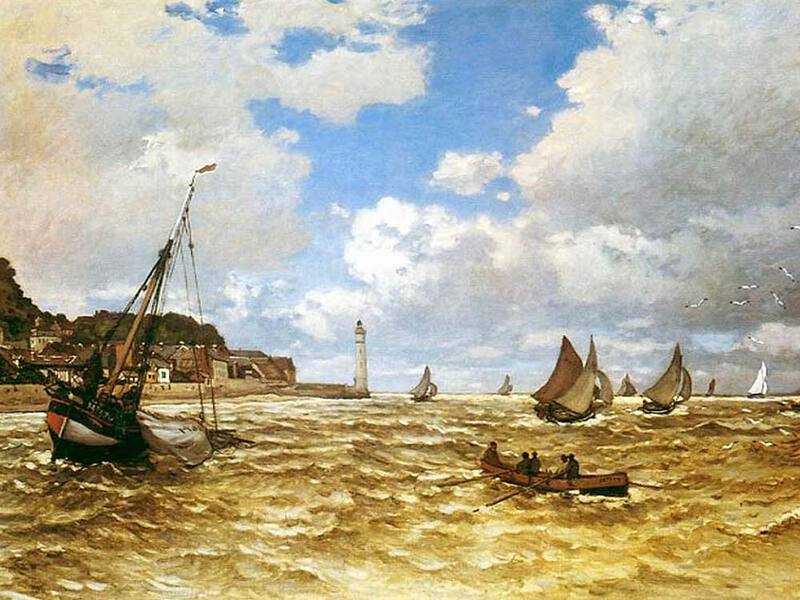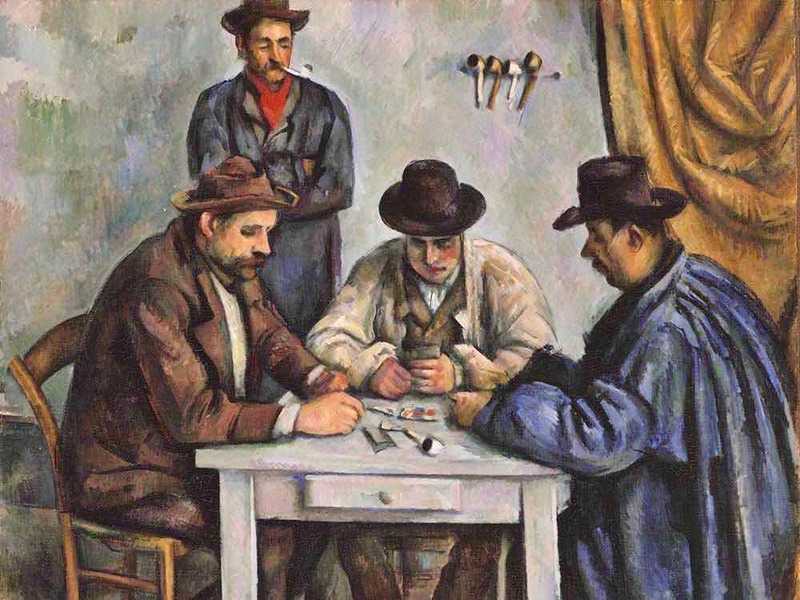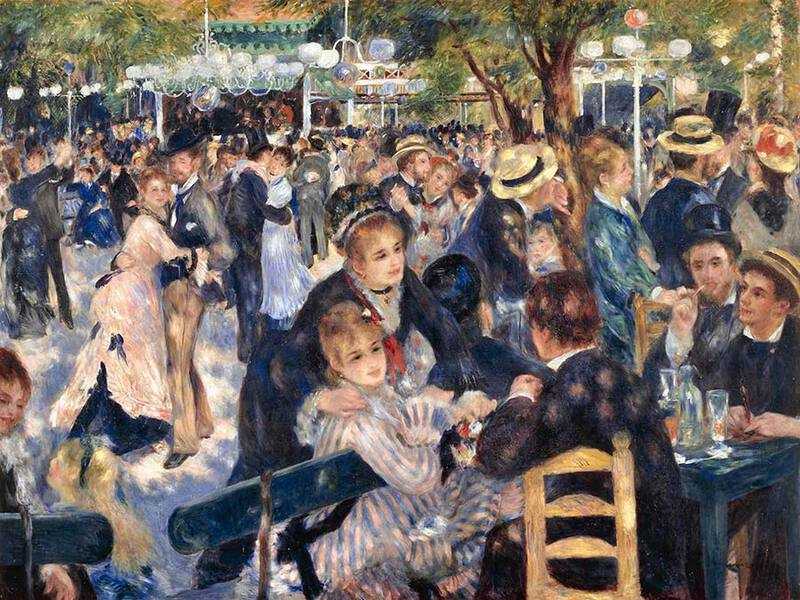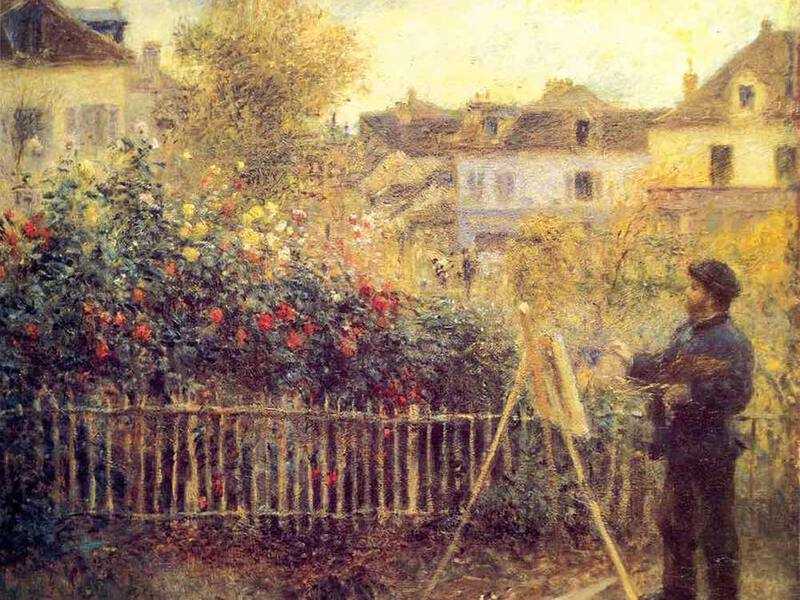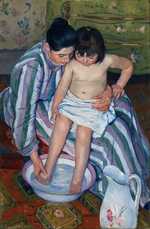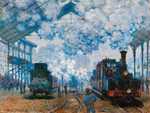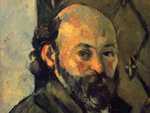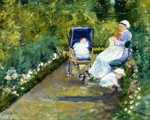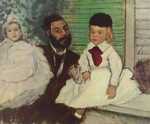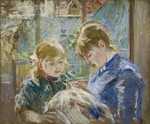1. Why is Impressionism important?
Impressionism began in Paris, France in the late 1800s. Before the Impressionists, most art was restricted to Academic and Neo-classical painting, which followed strict rules.
At this time, there was only one official exhibition of paintings in Paris, known as the Salon. A judging panel decided which paintings were allowed to be shown and which weren’t. They rejected any artists who didn’t fit their ideas of what a painting should look like.
When the Impressionists started painting in their new style, the Salon judges refused to accept most of their art into their exhibition. Determined not to give up, the Impressionists organised their own, independent exhibition to show off their work. This had a huge impact on French art as suddenly, artists were given an opportunity to paint what they wanted, not what the Salon said was good or bad.
Impressionism changed art in the 19th and 20th century by breaking free of the rules of normal painting. They showed that painting didn’t have to be really realistic and perfect, instead it could be painted quickly, outdoors and in natural light, with lots of brushstrokes and bold colours.
2. What did the Impressionists paint?
The Impressionists were really important because they chose to focus on ordinary life in their paintings. Before the Impressionists, most artists painted imaginary landscapes.
They also often painted stories from myth or history, which the artists recreated using their imagination. Instead, the Impressionists painted what they saw around them, which included normal people at work and doing their hobbies.
The Impressionists also tried to capture a moment in time - a Sunday afternoon in Paris, butchers working in a market, or the light on a row of trees. They looked carefully at the effects of light and the weather and painted what they saw. The quick, sketch style of their paintings helped the Impressionists to take a snapshot of these scenes.
3. Who are the most famous Impressionist painters?
Of all the Impressionist artists, there were some who became more famous than others. Many of them helped to start the Impressionist movement like Claude Monet, Camille Pissarro, Auguste Renoir and Berthe Morisot.
Then there are more famous artists who became interested in the Impressionist style and started experimenting with their own Impressionist paintings that were a bit different to the other Impressionists’ style. Some of these artists were Paul Cézanne and Mary Cassatt.
4. Impressionist activities to do at home
Now you know the basics behind Impressionism, why not have a go at doing some Impressionist activities? Here are some ideas to help you look, think and paint like an Impressionist artist!
Many of these activities can be done by children on their own but some will need the help of an adult, especially with younger children.
- Observe the colours from your window
- Track the sun
- Do a speed sketch
- Make paper flowers
- Write a story about an Impressionist painting
- Do some Impressionist inspired baking
- Experiment with textures
- Play Impressionist snap!
- Colour in an Impressionist painting
- Try to paint like an Impressionist
1. Observe the colours from your window
The Impressionists tried to take their colours from the natural world. They painted what they saw, even if the colours did not match or look very artistic. To them, observation was one of the most important steps in making a painting.
See if you can think like an Impressionist by looking out of a window in your home and listing every colour you can see. Write them down on a piece of paper and try use descriptive words like ‘bright’, ‘rich’, ‘dark’, ‘dappled’, and ‘smooth’.
Pay attention to different shades of the same colour: • Can you see more than one type of green? • Are the clouds just white or are there other colours too? • Are bricks all the same colour? • What is the colour you can see the most?
You can repeat this activity on another day as well. The colours will change when you have different weather. If it’s rainy, things tend to look greyer whereas on sunny days, colours appear brighter.
2. Track the sun
As well as paying a lot of attention to colours, the Impressionists were obsessed with sunlight. They painted outdoors to allow them to observe the effects of natural light on the objects they were painting, and they often painted the same scene over and over again at different times of the day. This allowed them to observe the changes that happened as the sun moved across the sky.
You can do the same thing by taking a photo in the same position, looking at the same scene at different times over one day. Ideally, you need to pick a sunny day for this activity.
Step 1
Start in the morning and choose your scene. If you can go outside, find somewhere that has a focal point like a tree or a bench. If you’re inside, you can do this activity from your window. You could focus on a tall building or a wall if you can’t find a tree.
Step 2
Take a photo in the morning. Then take a new photo every 3-4 hours through the day. Try to stand in exactly the same position to take the photo. If you do this in the spring or summer, you might be lucky to see a sunset too.
Step 3
At the end of the day or the next morning, print out all the photos you took or make them into a gallery on your phone or computer.
Try to see how the scene changes at different times of the day.
You might like to have a go at answering these questions:
• How does the object change colour? • How do the shadows change? • Does the sky look different? • Does the atmosphere of the pictures change? E.g. Are some photos softer? Gloomier? Livelier • Which is your favourite time of day?
Many of the Impressionists enjoyed painting in the evenings and early morning to capture the effect of sunrise and sunset on their scenes.
3. Do a speed sketch
Now you’ve learnt to see like an Impressionist, you could try sketching like one! The Impressionists liked to paint in oil paints on canvas, but many also sketched with pencil on paper.
For this Impressionist challenge, you’ll need: one pencil, a pad of white paper and a piece of fruit or a flower.
If you don’t have either of the last two, you can just choose your favourite object in your home.
Step 1
Put your object (your fruit or your flower) on a flat surface. Set a timer to 2 minutes and try to draw your object as complete as possible.
Step 2
Add in any textures you can see. Look at the darker areas of the object and the parts where the light falls on them. You can shade in the darker areas in your drawing with your pencil.
Step 3
At the end of your two minutes, stop! Step away and see how you’ve done. This challenge is to get you to think fast like the Impressionists and capture the things you see immediately!
You could choose another object and try again or have a go at sketching the same object for a second time. You might find that it’s better than the first time, this is because you will be more familiar with the shape and the shadows. The more you practice, the better your drawing will be!
4. Make paper flowers
From Monet’s waterlillies to Caillebotte’s chrysanthemums and Morisot’s peonies, the Impressionists painted flowers regularly. Flowers feature in a wide range of Impressionist paintings, popping up in still lifes, landscapes and portraits, and they’re the inspiration for this activity!
You can make any type of flower you like but a good one to get started with is a paper water lily.
To make a paper water lily, you’ll need: 4 sheets of thick paper or 4 paper plates, scissors, a pencil, a rubber, glue or tape.
Step 1
On one paper plate, draw out a large flower with 8 petals. Cut out the shape carefully using scissors. Draw around your cut-out flower on the second paper plate and cut that out as well.
Step 2
Draw a smaller flower with 7 petals on another plate and cut it out, then draw around this flower onto another paper plate and cut out too. You should end up with 4 paper flowers, 2 large and 2 small.
Step 3
Using the end of a pencil, curl each of the petals inwards towards the centre. You may want to curl the smaller flower petals more tightly.
Step 4
Stack the curled flowers on top of each other with the largest and the bottom and the smallest two on the top. Make sure you’re happy with how they look and do more petal curling if you need to.
Step 5
Next, stick the two larger flowers together, one on top of the other. Try to make the petals visible on both by turning the top flower slightly before sticking. Repeat with the two smaller flowers, adding them on top of the larger ones.
You can also add a yellow dot in the centre or use some scrunched up yellow tissue paper to really make it look like a water lily!
Why not search online for more paper flower tutorials and make a whole array of Impressionist inspired blooms!
5. Write a story about an Impressionist painting
This is a great activity for older children, involving creative writing and art observation.
As well as painting landscapes and flowers, the Impressionists frequently painted people. They wanted to capture everyday life, including people at work or during their leisure time. The Impressionists used light to create atmosphere in their paintings, painting scenes at different times of the day and different months of the year to create particular emotional effects.
For this activity, choose an Impressionist painting with at least one person in it.
Study the detail of the painting, looking at the setting, the posture of the person or people and the colours. What are they doing in this painting?
Write 1 - 3 paragraphs imagining the story behind the painting. Try to put yourself in the person’s shoes, think about how they are feeling and what they might be thinking about at that moment. Imagine how it would feel like to be in that setting. Describe the sounds they can hear, the smells, how their body feels in that position. Try to use lots of adjectives (descriptive words).
Once you have written your paragraphs, you could try to write a full short story, with a beginning, middle and end. You could imagine what happens to those people after they leave the scene and create a whole adventure for them. Let your imagination run wild!
6. Do some Impressionist inspired baking
For a tasty activity, try making some Impressionist inspired cakes! This activity is all about getting creative with cake decorating. It’s great fun to do with children of all ages.
Start by making a basic cupcake recipe Whilst the cakes are cooking, make your buttercream but before you add the food colouring, divide the mixture into several different bowls. Add different food colouring to each of the bowls, trying to get softer, Monet-style colours. It helps to look at an Impressionist painting for reference! Don’t forget you can mix primary colours to make secondary colours as well, such yellow and blue to make green.
Instead of piping your icing, put small dabs of different buttercream colours on each cupcake, blending them to create an Impressionist-style topping. You could use a teaspoon or clean fingers. There’s no wrong way to do this so you can really have fun with it. Children of any age can have a go - after all, it’s much better that they eat icing than paint!
7. Experiment with textures
Children of any age can try being Impressionists for the afternoon with simple texture painting.
For this activity you’ll need: poster paints or acrylics, a paint palette or paper plate, art sponges or cotton wool balls, and thick plain paper.
Step 1
Look at an Impressionist painting like this one by Renoir or Alfred Sisley. Ask your child to tell you what they can see.
You might like to ask what colours they can see and what season they think it is. You could also ask what their favourite part of the painting is and why.
Step 2
Pour a little bit of each of the paints onto the palette and experiment with mixing them to make some of the colours you can see in the painting. Older children can do this on their own but younger children might need help, especially with making secondary colours.
Step 3
Using your sponges or cotton wool balls, dip them in the paint and then dab onto the thick paper. Younger children can work on making a flower whilst older children can make their own garden scenes, taking inspiration from the Impressionist paintings.
8. Play Impressionist Snap!
Suitable for playing with the whole family - young and old! - Snap is an ideal game for getting to know some of the most famous Impressionist paintings!
Simply print out a range of Impressionist paintings, making sure to make two copies of each one. Aim for at least 20 paintings. Try to make the images all the same size too so there’s no chance of cheating!
The rules of Snap are as follows: • In a group of 2, 3, or 4 people (you’ll need more cards for more players), shuffle the cards and give each player an equal number of cards. • Each player should keep their cards face down in a pile. • Take it in turns to turn one card over from the top of the pile and put it in the middle, making a centre pile. • When someone turns over a card that matches the card on top of the centre pile, the players have to say ‘Snap!’ • The player who says ‘Snap!’ the fastest wins the group pile and puts it at the bottom of their individual pile. • The player who wins all the cards from all the piles wins the game!
9. Colour in an Impressionist painting
Alternatively, for a calming and creative activity, have a go at some Impressionist colouring! Use these downloadable templates to get started [link] and choose your own colours for some of the Impressionists’ most famous masterpieces!
10. Try to paint like an Impressionist
Once you’ve had a good look at some Impressionist paintings, you can have a go at making your own! The Impressionists were inspired by scenes from ordinary life so you can choose a scene from around your home or garden.
Remember that the Impressionists worked quickly to capture their scene, using short brushstrokes and paying attention to the effects of natural light. Try mixing different shades of the same colour instead of painting objects all one colour to give your painting a more Impressionist feel.
It’s easiest if you draw a quick outline in pencil and then add paint on top, using little dabs of your brush rather than making big, solid blocks of colour. Get to know the Impressionists’ skill by trying out their style yourself.
Good luck!

